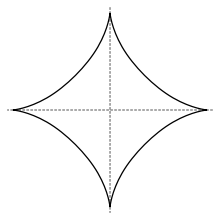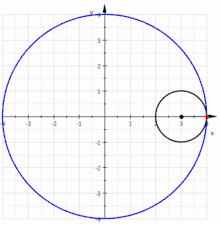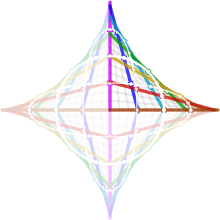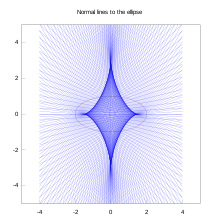Astroid
An astroid is a particular mathematical curve: a hypocycloid with four cusps. Specifically, it is the locus of a point on a circle as it rolls inside a fixed circle with four times the radius.[1] By double generation, it is also the locus of a point on a circle as it rolls inside a fixed circle with 4/3 times the radius. It can also be defined as the envelope of a line segment of fixed length that moves while keeping an end point on each of the axes. It is therefore the envelope of the moving bar in the Trammel of Archimedes.





Its modern name comes from the Greek word for "star". It was proposed, originally in the form of "Astrois", by Joseph Johann von Littrow in 1838.[2][3] The curve had a variety of names, including tetracuspid (still used), cubocycloid, and paracycle. It is nearly identical in form to the evolute of an ellipse.
Equations
If the radius of the fixed circle is a then the equation is given by[4]
This implies that an astroid is also a superellipse.
The pedal equation with respect to the origin is
the Whewell equation is
and the Cesàro equation is
The polar equation is[5]
The astroid is a real locus of a plane algebraic curve of genus zero. It has the equation[6]
The astroid is, therefore, a real algebraic curve of degree six.
Derivation of the polynomial equation
The polynomial equation may be derived from Leibniz's equation by elementary algebra:
Cube both sides:
Cube both sides again:
But since:
It follows that
Therefore:
or
Metric properties
- Area enclosed[7]
- Length of curve
- Volume of the surface of revolution of the enclose area about the x-axis.
- Area of surface of revolution about the x-axis
Properties
The astroid has four cusp singularities in the real plane, the points on the star. It has two more complex cusp singularities at infinity, and four complex double points, for a total of ten singularities.
The dual curve to the astroid is the cruciform curve with equation The evolute of an astroid is an astroid twice as large.
See also
- Cardioid (epicycloid with one cusp)
- Nephroid (epicycloid with two cusps)
- Deltoid (hypocycloid with three cusps)
- Stoner–Wohlfarth astroid a use of this curve in magnetics.
- Spirograph
References
- Yates
- J. J. v. Littrow (1838). "§99. Die Astrois". Kurze Anleitung zur gesammten Mathematik. Wien. p. 299.
- Loria, Gino (1902). Spezielle algebraische und transscendente ebene kurven. Theorie und Geschichte. Leipzig. pp. 224.
- Yates, for section
- Mathworld
- A derivation of this equation is given on p. 3 of http://xahlee.info/SpecialPlaneCurves_dir/Astroid_dir/astroid.pdf
- Yates, for section
- J. Dennis Lawrence (1972). A catalog of special plane curves. Dover Publications. pp. 4–5, 34–35, 173–174. ISBN 0-486-60288-5.
- Wells D (1991). The Penguin Dictionary of Curious and Interesting Geometry. New York: Penguin Books. pp. 10–11. ISBN 0-14-011813-6.
- R.C. Yates (1952). "Astroid". A Handbook on Curves and Their Properties. Ann Arbor, MI: J. W. Edwards. pp. 1 ff.
External links
| Wikimedia Commons has media related to Astroid. |
- "Astroid", Encyclopedia of Mathematics, EMS Press, 2001 [1994]
- Weisstein, Eric W. "Astroid". MathWorld.
- "Astroid" at The MacTutor History of Mathematics archive
- "Astroid" at The Encyclopedia of Remarkable Mathematical Forms
- Article on 2dcurves.com
- Visual Dictionary Of Special Plane Curves, Xah Lee
- Bars of an Astroid by Sándor Kabai, The Wolfram Demonstrations Project.